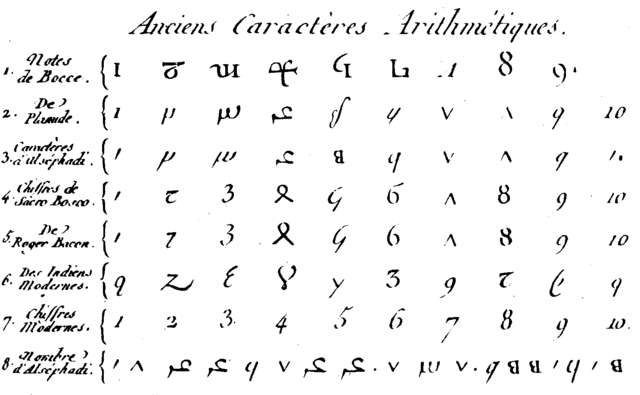Summary
| Description |
Early european variants of the arabian digits |
| Date |
1798 |
| Source |
Jean-Étienne Montucla, Histoire des Mathématiques, 1758 (1798 second edition), Tome 1, Planche XI, |
| Author |
J.E. Montucla |
Permission
( Reusing this file) |
author died 1799
|
Licensing
| Public domainPublic domainfalsefalse |
 |
This image (or other media file) is in the public domain because its copyright has expired.
This applies to Australia, the European Union and those countries with a copyright term of life of the author plus 70 years.
 You must also include a United States public domain tag to indicate why this work is in the public domain in the United States. Note that a few countries have copyright terms longer than 70 years: Mexico has 100 years, Colombia has 80 years, and Guatemala and Samoa have 75 years, Russia has 74 years for some authors. This image may not be in the public domain in these countries, which moreover do not implement the rule of the shorter term. Côte d'Ivoire has a general copyright term of 99 years and Honduras has 75 years, but they do implement the rule of the shorter term. You must also include a United States public domain tag to indicate why this work is in the public domain in the United States. Note that a few countries have copyright terms longer than 70 years: Mexico has 100 years, Colombia has 80 years, and Guatemala and Samoa have 75 years, Russia has 74 years for some authors. This image may not be in the public domain in these countries, which moreover do not implement the rule of the shorter term. Côte d'Ivoire has a general copyright term of 99 years and Honduras has 75 years, but they do implement the rule of the shorter term.
|
|
This file has been identified as being free of known restrictions under copyright law, including all related and neighboring rights.
|
Legend
In the above mentioned book, Montucla describes the various digits in detail. Here is a summary of the paragraph on page 375 to 381 (the first part is the part written in the image):
1. Notes de Boëce ;
2. De Planude, moine, XIIIe siècle, arithmétique indienne ou manière de calculer suivant les Indiens ;
3. Caractères d'al Séphadi, poëte arabe, sauf le zero les chiffres ne sont pas différents de ceux de Planude ;
4. Chiffres de Sacro Bosco, Sean de Sacro Bosco, Traité de l'arithmétique, XIIIe siècle ;
5. De Roger Bacon, Roger Bacon, calendrier ;
6. Des Indiens modernes ;
7. Chiffres modernes ;
8. Nombre d'Alséphadi ; exemple d'un nombre du Commentaire sur un fameux poëme arabe de Tograi, « 18446744073709551615 ».
Translation:
1. Notes de Boëce;
2. De Planude; monk, XIIIth century, Indian Arithmetic or Art to calculate like the Indians;
3. Caractères à al Séphadi; arabian poet, apart from zero the glyphs don't differ from the ones of de Planude;
4. Chiffres de Sacro Bosco; Sean de Sacro Bosco, Work on Arithmetic, XIIIth century;
5. De Roger Bacon; Roger Bacon, Calendar;
6. Des Indiens Modernes;
7. Chiffres Modernes;
8. Nombre d'Alséphadi; Exemple of a number from the book "Commentary of a famous arabian poem from Tograi", the number is 18446744073709551615.
The following pages on Schools Wikipedia link to this image (list may be incomplete):



